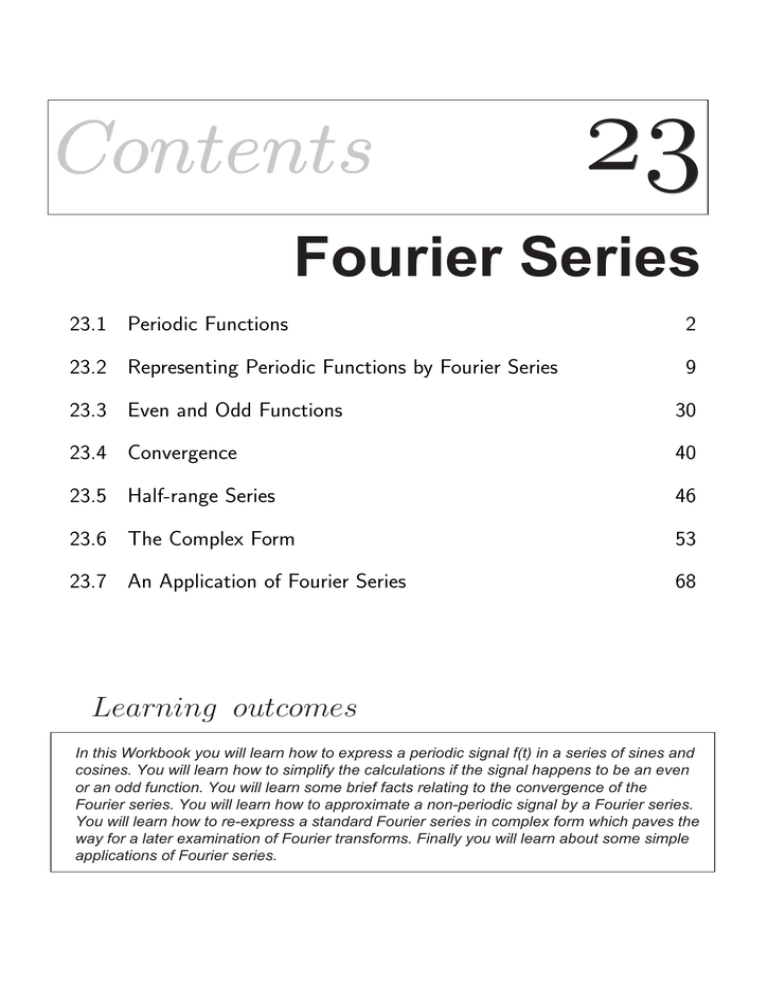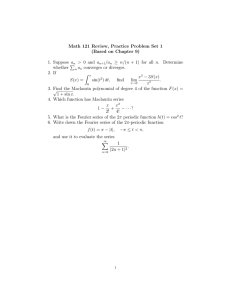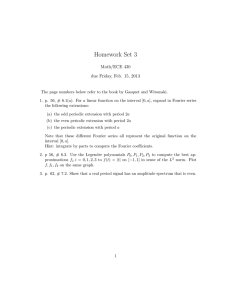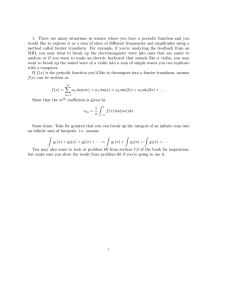Periodic Functions
advertisement

Contents 23 Fourier Series 23.1 Periodic Functions 2 23.2 Representing Periodic Functions by Fourier Series 9 23.3 Even and Odd Functions 30 23.4 Convergence 40 23.5 Half-range Series 46 23.6 The Complex Form 53 23.7 An Application of Fourier Series 68 Learning outcomes In this Workbook you will learn how to express a periodic signal f(t) in a series of sines and cosines. You will learn how to simplify the calculations if the signal happens to be an even or an odd function. You will learn some brief facts relating to the convergence of the Fourier series. You will learn how to approximate a non-periodic signal by a Fourier series. You will learn how to re-express a standard Fourier series in complex form which paves the way for a later examination of Fourier transforms. Finally you will learn about some simple applications of Fourier series. Periodic Functions 23.1 Introduction You should already know how to take a function of a single variable f (x) and represent it by a power series in x about any point x0 of interest. Such a series is known as a Taylor series or Taylor 16. Such an expansion expansion or, if x0 = 0, as a Maclaurin series. This topic was firs met in is only possible if the function is sufficiently smooth (that is, if it can be differentiated as often as required). Geometrically this means that there are no jumps or spikes in the curve y = f (x) near the point of expansion. However, in many practical situations the functions we have to deal with are not as well behaved as this and so no power series expansion in x is possible. Nevertheless, if the function is periodic, so that it repeats over and over again at regular intervals, then, irrespective of the function’s behaviour (that is, no matter how many jumps or spikes it has), the function may be expressed as a series of sines and cosines. Such a series is called a Fourier series. Fourier series have many applications in mathematics, in physics and in engineering. For example they are sometimes essential in solving problems (in heat conduction, wave propagation etc) that involve partial differential equations. Also, using Fourier series the analysis of many engineering systems (such as electric circuits or mechanical vibrating systems) can be extended from the case where the input to the system is a sinusoidal function to the more general case where the input is periodic but non-sinsusoidal. Prerequisites • be familiar with trigonometric functions Before starting this Section you should . . . ' $ • recognise periodic functions Learning Outcomes On completion you should be able to . . . & 2 • determine the frequency, the amplitude and the period of a sinusoid • represent common periodic functions by trigonometric Fourier series HELM (2008): Workbook 23: Fourier Series % ® 1. Introduction You have met in earlier Mathematics courses the concept of representing a function by an infinite series of simpler functions such as polynomials. For example, the Maclaurin series representing ex has the form x2 x3 ex = 1 + x + + + ... 2! 3! or, in the more concise sigma notation, ex = ∞ X xn n=0 n! (remembering that 0! is defined as 1). The basic idea is that for those values of x for which the series converges we may approximate the function by using only the first few terms of the infinite series. Fourier series are also usually infinite series but involve sine and cosine functions (or their complex exponential equivalents) rather than polynomials. They are widely used for approximating periodic functions. Such approximations are of considerable use in science and engineering. For example, elementary a.c. theory provides techniques for analyzing electrical circuits when the currents and voltages present are assumed to be sinusoidal. Fourier series enable us to extend such techniques to the situation where the functions (or signals) involved are periodic but not actually sinusoidal. You may also see in 25 that Fourier series sometimes have to be used when solving partial differential equations. 2. Periodic functions A function f (t) is periodic if the function values repeat at regular intervals of the independent variable t. The regular interval is referred to as the period. See Figure 1. f (t) t period Figure 1 If P denotes the period we have f (t + P ) = f (t) for any value of t. HELM (2008): Section 23.1: Periodic Functions 3 The most obvious examples of periodic functions are the trigonometric functions sin t and cos t, both of which have period 2π (using radian measure as we shall do throughout this Workbook) (Figure 2). This follows since sin(t + 2π) = sin t and cos(t + 2π) = cos t y = sin t y = cos t 1 1 π π t 2π period 2π t period Figure 2 The amplitude of these sinusoidal functions is the maximum displacement from y = 0 and is clearly 1. (Note that we use the term sinusoidal to include cosine as well as sine functions.) More generally we can consider a sinusoid y = A sin nt which has maximum value, or amplitude, A and where n is usually a positive integer. For example y = sin 2t 2π = π (Figure 3). The fact that the period is π follows is a sinusoid of amplitude 1 and period 2 because sin 2(t + π) = sin(2t + 2π) = sin 2t for any value of t. y = sin 2t 1 π π 2 t period Figure 3 4 HELM (2008): Workbook 23: Fourier Series ® We see that y = sin 2t has half the period of sin t, π as opposed to 2π (Figure 4). This can alternatively be phrased by stating that sin 2t oscillates twice as rapidly (or has twice the frequency) of sin t. y = sin t y = sin 2t 1 π 2π t Figure 4 2π and completes n oscillations when t changes In general y = A sin nt has amplitude A, period n by 2π. Formally, we define the frequency of a sinusoid as the reciprocal of the period: frequency = 1 period and the angular frequency, often denoted the Greek Letter ω (omega) as angular frequency = 2π × frequency = Thus y = A sin nt has frequency 2π period n and angular frequency n. 2π Task State the amplitude, period, frequency and angular frequency of 2t (a) y = 5 cos 4t (b) y = 6 sin . 3 Your solution (a) Answer amplitude 5, period 2π π 2 = , frequency , angular frequency 4 4 2 π Your solution (b) Answer amplitude 6, period 3π, frequency HELM (2008): Section 23.1: Periodic Functions 1 2 , angular frequency 3π 3 5 Harmonics In representing a non-sinusoidal function of period 2π by a Fourier series we shall see shortly that only certain sinusoids will be required: (a) A1 cos t (and B1 sin t) These also have period 2π and together are referred to as the first harmonic (or fundamental harmonic). (b) A2 cos 2t (and B2 sin 2t) These have half the period, and double the frequency, of the first harmonic and are referred to as the second harmonic. (c) A3 cos 3t (and B3 sin 3t) 2π These have period and constitute the third harmonic. 3 In general the Fourier series of a function of period 2π will require harmonics of the type An cos nt ( and Bn sin nt) where n = 1, 2, 3, . . . Non-sinusoidal periodic functions The following are examples of non-sinusoidal periodic functions (they are often called “waves”). Square wave 1 f (t) π −π t 2π −1 Figure 5 Analytically we can describe this function as follows: −1 −π < t < 0 f (t) = (which gives the definition over one period) +1 0<t<π f (t + 2π) = f (t) (which tells us that the function has period 2π) Saw-tooth wave f (t) 4 −2 2 4 t Figure 6 In this case we can describe the function as follows: f (t) = 2t 0<t<2 Here the period is 2, the frequency is 6 f (t + 2) = f (t) 1 2π and the angular frequency is = π. 2 2 HELM (2008): Workbook 23: Fourier Series ® Triangular wave π f (t) −π π 2π t Figure 7 Here we can conveniently define the function using −π < t < π as the “basic period”: −t −π < t < 0 f (t) = t 0<t<π or, more concisely, f (t) = |t| −π <t<π together with the usual statement on periodicity f (t + 2π) = f (t). Task Write down an analytic definition for the following periodic function: f (t) 2 −5 −3 −2 3 −1 2 5 t Your solution Answer 2−t f (t) = −1 0<t<3 3<t<5 HELM (2008): Section 23.1: Periodic Functions f (t + 5) = f (t) 7 Task Sketch the graphs of the following periodic functions showing all relevant values: 2 0<t<4 t /2 8 4<t<6 (a) f (t) = f (t + 8) = f (t) 0 6<t<8 (b) f (t) = 2t − t2 0<t<2 f (t + 2) = f (t) Your solution Answer f (t) (a) 8 4 6 8 period t f (t) (b) 1 2 t period Figure 9 8 HELM (2008): Workbook 23: Fourier Series








